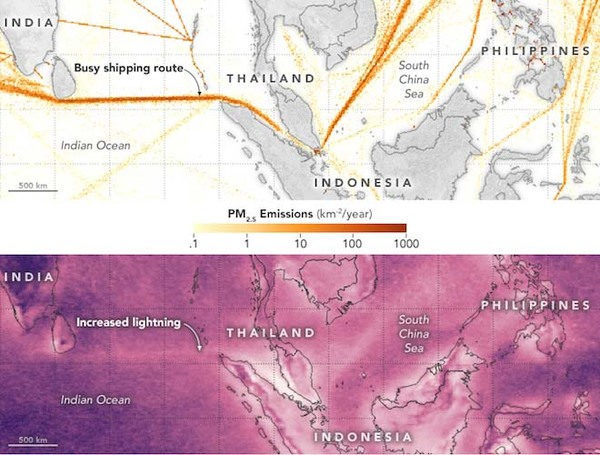How people affect the appearance of lightning

2017-12-15 19:55
How people affect the appearance of lightning
This phenomenon is most often found on land than over the oceans, mainly in the areas located closer to the equator than in mid-and high latitudes.

Sign up for news “UkrMedia” in Facebook, Twitter or Google+
The probability of lightning flashes is not the same everywhere, reports Rus.Media. This phenomenon is most often found on land than over the oceans, mainly in the areas located closer to the equator than in mid-and high latitudes. According to a recent study conducted by Joel Thornton, a specialist in the atmosphere at the University of Washington, people can also influence the occurrence of an electrical discharge in the sky.
The relationship between people and lightning can be seen in the areas of the two busiest shipping lanes in the world in the Indian ocean and the South China sea. On the upper map shows the orange emission of particles from the exhaust gases of the vessel calculated on the basis of a database on Maritime traffic in the region. The second map shows the average density of lightning per year from 2005 to 2016, according to the world network of localization of lightning (WWLLN). A narrow light-purple bars indicate where there was an increase in the number of lightning. Comparing these two figures we can see that the area with the highest number of lightning coincide with the routes of ships.
The researchers found that the average frequency of lightning over navigable waterways is twice more than in the areas immediately adjacent to these bands. “It was a surprise to find this feature in the data, and so clearly expressed. Our discovery is one of the most striking examples of human impact on the atmosphere, the consequence of which is increased lightning storms,” said Thornton. He noted that the idea of the influence of aerosol particles on the intensity of storms and lightning has been discussed for more than a decade, but scientists could not come to a consensus on the importance of this effect.
Ground sensors recorded WWLLN lightning around the planet. Recently, the work of Katrina Virtsu, an expert on the atmosphere in the space flight Center. Marshall, NASA, made the network even more valuable. Recycling global climatology of lightning, she was able to increase the resolution five times. Now the location of lightning strikes can be determined with a precision of 10 square kilometers.
These maps are high resolution led Thornton and his colleagues to the hypothesis that ship emissions affect the appearance of lightning. The group compared data on surface zip in the shipping lanes of the Indian ocean with data obtained by the Lightning Imaging Sensor instrument on the satellite Tropical Rainfall Measuring Mission (TRMM).
They also used TRMM radar data to check whether certain parts of the cumulonimbus clouds contain more droplets of fluid among the particles of water vapor and ice. Such an increase could occur if the particles from the ship exhaust was changed the structure of the clouds in the area.
“Our results show that aerosol particles from the exhaust gases actually turn a tropical storm into a thunderstorm with lightning, increasing vertical development of storms,” concluded Thornton.











